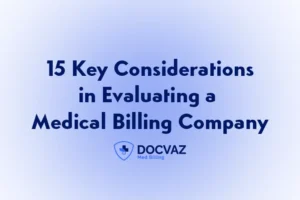Thank You For Selecting Quality Care – We Are Here To Support You!
We know that healthcare can be complicated, but your billing shouldn’t be. This statement reflects the clinical facilities you get, along with a clear breakdown of fees, insurance payments, and any remaining balances. Our medical billing services team is devoted to making your experience as smooth and transparent as possible. If you have any queries about the charges or insurance processes, or payment options, please do not hesitate to reach out. We are here to support you in understanding every detail. Your health is our priority – and so is your peace of mind!
What is a Patient Billing Statement?
A patient billing statement is a summary of all medical fees, insurance payments, adjustments, and patient payments related to the care provided. It generally includes:
- Date and details of facilities.
- Provider and service charges.
- Insurance contributions and adjustments.
- Patient’s financial responsibility.
- Payment records and outstanding balance.
Its primary purpose is to clearly communicate what patients owe, confirming transparency and reducing billing disputes.
Who Sends Billing Statements?
Billing statements are generally issued by the provider’s billing department, such as clinics or physicians’ clinics. However, multiple practices outsource these tasks to professional medical billing organizations such as DocVaz, which ensures accurate, timely, and compliant billing.
How often must billing statements be sent?
Most healthcare providers default to sending billing statements monthly. However, this frequency might not be perfect for every practice or patient group.
|
Standard Frequency: Monthly, Every 30 Days |
Enhanced Frequency: Bi-Weekly Or Weekly |
|
This is common but might cause:
|
Sending statements more often:
|
What are the main components of a patient’s statements?
Here are the essential portions of the billing statement:
Demographic Details:
- Having the precise demographic information confirms that the billing statement researches the rectify the person, and the information is easy to identify.
Services Detailed Information:
- This portion lists all medical facilities provided, such as methods, medications, and the date of the facilities. It supports patients knowing exactly what facilities they are being billed for, making the statement clear and transparent.
Medical Codes And Descriptions:
- It uses standard medical codes, such as CPT and HCPCS, to describe the clinical facilities provided. Every code comes with a shirt description of the facilities. Accurate coding is essential to confirm the correct repayment and smooth insurance claims.
Payment Record:
- The section details all payments made by the individuals associated with the patient so far, involving the date and quantity paid or still owed. This supports a sustained record and confirms that everything is recorded and rectified for transparency.
Due Date:
- The due date is the accurate date when the individual’s payment is expected. Clearly stating the due dates supports avoiding confusion and confirms that payments are made on time.
Contact Information:
- This section sets out the information on when an individual can contact the billing department if they have questions or issues. It generally involves a phone number, email address, and the billing department’s physical address.
What is the process to generate the patient-friendly billing statement?
Creating a clear, exact, and user-friendly statement takes a few steps:
Step 01: Collect all the data
- Take the details from your EHR and practice management system.
- Collect facilities dates, method codes, and patients’ details
Step 02: Verification of accurate data
- Confirms facilities codes match methods performed.
- Ensures insurance coverage and eligibility.
- Make sure the individual’s information is correct and up to date.
Step 03: Create a statement
Use revenue cycle management software to generate the statement. The statement must:
- Be easy to read.
- Use clear wording.
- Itemize every charge.
Step 04: Quality control
Review that statement properly for:
- Math errors.
- Incorrect adjustments.
- Misapplied payments.
A second set of eyes supports preventing mistakes that can delay payments.
Step 05: Deliver the statement
Select a delivery method based on the patient’s preferences:
- Email.
- Patient portal.
- Printed and mailed copy.
Patient-Friendly Billing Statement Formats
Healthcare providers utilize distinctive formats and structures to confirm accessibility, ease, and patient satisfaction levels. The options of format may be based on the patients’ preferences and accessible technology, as well as compliance requirements.
Electronic statement
Sent through the email, the patients’ portal, and e-statement offer rapid, easy access to the billing details. They can be automated and are easy to download or print, and they help lower paper usage.
Paper statements:
The statements ar mailed directly to the patient’s home, and paper statements are perfect for those who prefer physical copies or those with deficiencies in internet access. They involve all essential billing details in printed form.
Hybrid strategy:
It may offer you both electronic and paper options, permitting the patients to select their preferred formats and structures. This is a flexible process that enhances the satisfaction and confirms your billing information is accessible to all.
Simplify your billing – Let DocVaz Medical Billing Company handle patient statements!
At DocVaz, we streamline your billing method with a customized, automated patient statements solution. Here is how we make it easy:
- Workflow Analytics: We evaluate the current billing workflow, which involves patient visit frequency and insurance coverage details, to know your practice’s requirements.
- Personalizing Billing Schedule: Based on the analytics, we suggest you perfect a billing schedule – weekly and bi-weekly or monthly for maximizing efficiency.
- Addressed Statements: Our systems automatically send the billing statements in a personalized format, decreasing the manual errors and saving valuable time.
FAQ’s
Why are patient-friendly statements essential?
They decrease the confusion, enhances trust, and increase the likelihood of on-time payments by making billing more transparent and knowledgeable.
Why must I be involved in the statements?
The main key factors are date or facilities, description of facilities, total charges, insurance payments, and clear payment guidelines.
How can I make statements easier to read?
Applies plain language, organized layouts, bold headings, and prevents clinical or billing jargon where chances of posiibilities.
Should contact information be involved?
Yes, always involves a phone number, email, or website where people can get support with queries or payment choices.
How often must statements be sent?
Perfectly, send them properly promptly after the insurance processing - generally every 30 days until the balance is resolved.
Can digital statements be patient-friendly too?
Yes, many patients prefer email or portal accessibility. Just make sure the digital version is mobile-friendly and easy to navigate.




